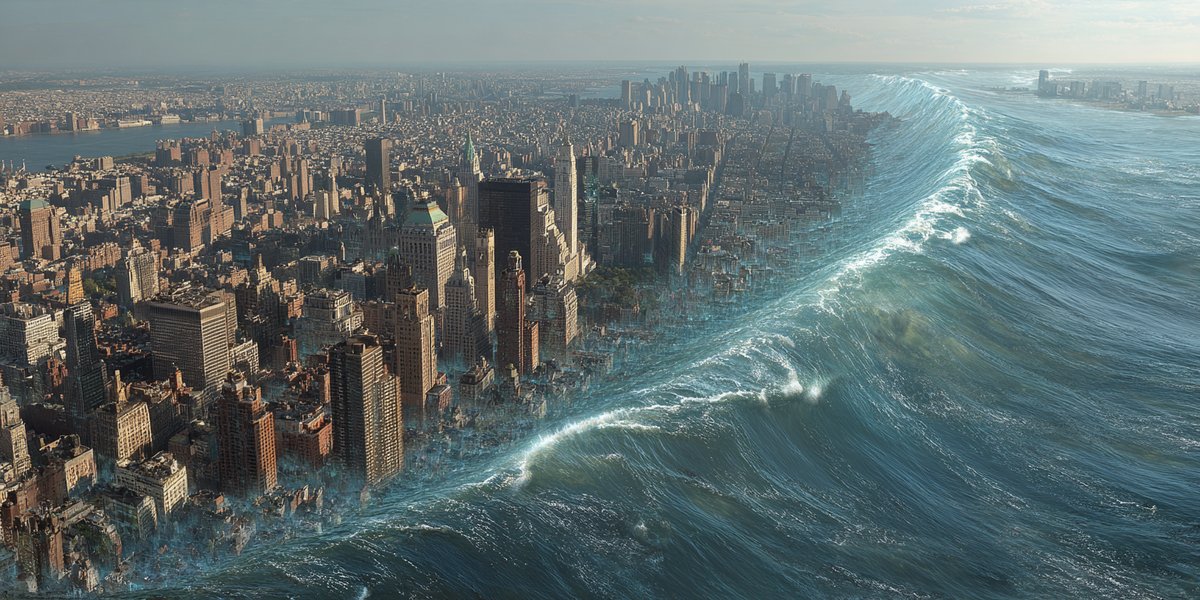On an autumn evening not long ago, New Yorkers watched the impossible become real. Lower Manhattan—epicenter of global finance, culture, and ambition—slipped beneath the churning tide of a storm surge. Subway tunnels flooded like inverted aqueducts. Power grids blinked out, leaving millions in darkness. Supermarkets were stripped bare within hours. It was more than a weather event; it was a revelation, a stark glimpse of the fragility concealed beneath the steel-and-glass veneer of modern civilization.
That image is not only a warning about climate change. It is a parable about the very architecture of the twenty-first century. Our greatest triumphs have been the concentration of humanity into vast, hyper-efficient cities and the simultaneous concentration of our commerce, memory, and knowledge into a single, global digital nervous system. These are the engines of our prosperity, the infrastructures that transformed survival into abundance and connected a fragmented planet into a living, breathing whole.
But there is a paradox hidden at their core. The very concentration that has delivered unmatched efficiency has also engineered an exquisite brittleness. We have traded resilience for optimization, redundancy for speed, and decentralization for the illusion of control. The city, once humanity’s strongest defense against scarcity, is now an ecosystem balanced on a knife’s edge of just-in-time logistics. The internet, designed as a decentralized web of resilience, has ossified into a hierarchy of critical hubs whose failure could ripple across continents.
This is the uncomfortable truth: the twin pillars of modern civilization—dense urban centers and a global digital infrastructure—are also its most exposed Achilles’ heels. Their interdependence is intricate, their operations streamlined to perfection, but their capacity to absorb shock is alarmingly thin. A single, well-placed disruption—whether natural or human-made—has the potential not merely to inconvenience, but to unmake the world as we know it.
The Urban Paradox
Cities have always been celebrated as humanity’s crowning achievement. They are engines of innovation, crucibles of culture, and the staging grounds for economic miracles. But beneath the skyscrapers and subway lines lies a truth that rarely fits into glossy tourist brochures: the modern metropolis is an exquisitely fragile machine, one that functions only as long as every gear spins without interruption.
Nowhere is this fragility clearer than in the myth of abundance that wraps itself around city life. Walk into any supermarket in New York, London, or Tokyo and the shelves seem bottomless. Yet most of those shelves hold only three days’ worth of food. Behind the neat rows of produce and packaged goods lies a supply chain designed not for resilience but for ruthless efficiency. The “just-in-time” model, perfected to minimize costs and reduce waste, has erased the stockpiles that once buffered societies against disruption. One broken highway, one paralyzed port, and the illusion of infinite supply evaporates in hours.
And when disruption strikes, it rarely stops at the warehouse door. A city is not a collection of isolated systems but an interdependent web where every function leans on another. A blackout is never just a loss of light—it is water pumps grinding to a halt, sewage systems backing up, traffic signals collapsing into chaos, gas stations unable to pump fuel, and hospitals relying on generators that may themselves soon run dry. Like dominoes falling in sequence, one failure triggers another, until the city’s intricate choreography collapses into silence.
In this way, the modern metropolis is both triumph and trap. Its efficiency is dazzling, its pace unmatched, but its very optimization ensures that every part is critical—and therefore every part is a potential point of catastrophic failure. Cities are not resilient fortresses. They are brittle ecosystems, balanced on the thin edge of perfection.
The Glass Nervous System
If cities are the body of modern civilization, the internet is its nervous system—a lattice of signals, switches, and circuits that coordinates the daily pulse of life. We speak of “the cloud” as if it were something ethereal, hovering beyond reach, an infinite, untouchable presence. But the cloud is no such thing. It is concrete, humming, and shockingly fragile. Behind every email, bank transfer, and video call stands a warehouse of servers, each one dependent on stable electricity, delicate cooling systems, and networks of cables no less physical than a city’s subway lines.
This illusion of weightlessness hides an uncomfortable truth: our digital nervous system is susceptible to the same disasters that haunt our cities. A flood can take out a data center as easily as a subway tunnel. A regional blackout can silence financial exchanges as readily as it plunges neighborhoods into darkness. A single fiber cut in a major hub can choke off entire regions, reducing the myth of global connectivity to the reality of isolation.
The fragility extends far beyond Earth itself. Hovering above us, in a thin shell of orbit, are the satellites that synchronize clocks, route planes, guide trucks, and time every financial transaction. These machines are the invisible scaffolding of modern life, and yet they hang vulnerable in a cosmic shooting gallery. A solar flare like the Carrington Event of 1859—an inevitability on a long enough timeline—could fry this orbital lattice and cripple the very power grids on which it depends. In a matter of hours, the nervous system of modern society could seize up, leaving its great urban body uncoordinated and blind.
We have entrusted the operation of our civilization to this glass nervous system, optimized for speed and reach, but delicate in both design and defense. It is a marvel of ingenuity—but also a machine whose failures could ripple through every corner of human life, from the checkout line to the control room.
The Intersection of Crises
The gravest danger does not lie in the vulnerabilities of cities or networks taken in isolation. It emerges from their collision—the moment when the physical body of civilization and its digital nervous system break together.
Imagine a hurricane bearing down on Miami. The winds and floods tear through coastal neighborhoods, but the damage does not stop at shattered glass and drowned streets. The city is also home to data centers and cable landing stations that tie much of the southeastern United States into the global internet. As the waters rise, servers short out, generators fail, and fiber connections go dark. What began as a regional disaster suddenly metastasizes into a digital blackout rippling far beyond Florida’s borders.
Now consider the aftermath. Other cities, untouched by the storm itself, depend on those connections for logistics, communication, and financial transactions. With digital arteries severed, trucks can’t coordinate deliveries, hospitals can’t confirm supply orders, banks can’t settle trades. Even the power grids of distant states may wobble, because their balancing systems rely on signals that once flowed through the now-silenced hub. The physical disaster and the digital collapse feed each other in a feedback loop of failure, radiating instability outward like shockwaves from a single blast.
This is the vicious symbiosis of modern life. Cities cannot function without the digital network that guides their flows of energy, food, money, and people. Yet that network is anchored in the very urban centers most exposed to storms, earthquakes, and human conflict. Each depends on the other for survival, and each magnifies the other’s collapse.
The metaphor is inescapable: the city is the body, the network its nervous system. An injury to one is survivable; an injury to both is fatal. And our world has arranged itself so that both can break together.
The Quiet Abandonment of Resilience
The paradox of modern civilization is stark: the very forces that propelled us into an age of abundance now leave us exquisitely vulnerable. In our drive to concentrate people into cities and information into networks, we achieved efficiencies that once seemed miraculous. Yet those triumphs came at a cost—the erosion of redundancy, the stripping away of buffers, the quiet abandonment of resilience.
The evidence is plain. Cities built on just-in-time supply chains teeter when trucks halt for even a day. Power grids and water systems cascade into failure when a single element falters. Our digital nervous system, bound up in fragile servers and orbiting satellites, could be unraveled by a flood, a blackout, or a solar storm. And when these systems fail together, the result is not inconvenience but paralysis, a civilization suddenly unable to coordinate its own survival.
The challenge of the nineteenth and twentieth centuries was to build these intricate engines of concentration. The challenge of the twenty-first is to relearn what earlier ages knew instinctively: that survival requires resilience. It requires redundancy, decentralization, and margins for error. The future will not be safeguarded by greater efficiency, but by the deliberate design of slack, buffers, and alternatives.
If the city is our body and the network our nervous system, then resilience is the immune system we have neglected. Rebuilding it will be the defining task of our century. For the storm surge is coming again—whether by weather, accident, or attack—and only those who have learned to bend without breaking will endure.
om tat sat


Member discussion: